Congressional Country Club (Blue), Bethesda, Maryland - Golf Course Review
Congressional Country Club (Blue)
Bethesda, Maryland, United States
Architects: Devereux Emmet (1924), Renovations by Robert Trent Jones Sr. (1957), Rees Jones (1989, 2006)
7,574 Yards, Par-71
Course Rating / Slope: 75.4 / 142
My Quick Review: A true championship test on ideal parkland terrain.
I have to admit, I came into Congressional with muted expectations. I was warned that the golf course is a long, boring slog that has been Rees Jones-ified. I suppose to some extent I agree with the critics, but with the knowledge that Congressional has been modified to be a 'championship' test, I came away pleasantly surprised (I feel the same way about Atlanta Athletic Club).
Thanks to a miscommunication between me and the Club secretary, I played Congressional alone. I have to say, as much as it's nice to have a caddie or someone familiar with the course to show you around, it really is a cool feeling to tee-off on the first hole knowing you are going to discover the golf course on your own.
What you don't get a feel for on the first couple of holes is the wonderful land movement. No matter how redundant the bunkering, or poor the mowing lines, Congressional will always be blessed with near ideal parkland golfing terrain.

At the 1st, the golfer finds a demanding tee shot with fairway bunkering flanking the fairway (typical) and a simple, oval green that relies predominantly on tilt over contour (not typical).

The second is another demanding hole (I should stop using the word demanding as near every hole 'demands' a lot from the golfer), an uphill 220 yard par-3 to a tiered green:

The 3rd is the front half of two long up and back par-4s over rolling terrain. The third hole moves left...

And offers a deep green with a ridge across its centre:

And the 4th moves right and though my picture did not come out, has a shallow and wildly contoured green:

The 5th is a 'breather' hole, a par-4 that plays under 400 yards:

Blindness from the tee on the 550 yard par-5 6th:

And an approach to a green with a swale in the centre set hard against the lake:

Another uphill par-3 at the 7th:

The 350 yard par-4 8th is the best hole on the golf course. One of a handful of holes that plays across the tilt of the land. The tee shot plays to a fairway that tilts hard to the right toward a lone fairway bunker.

Playing to the high side of the fairway leaves an approach that plays straighter into this sharply angled green:

A tee box cut into the middle of nowhere allows the par-5 9th to play over 600 yards. For most, the second shot will be a lay-up short of a steep drop-off 90 yards from the green:


After crossing the putting green and Gold Course's 1st tee, the golfer reaches the tee of the 10th hole, which is certainly one of the two most well-known on the course. Members sitting in the grill have an excellent view of the 10th -- and I can tell you from experience that some will have a wry smile as one golfer after another dumps a ball in the water! This par-3 plays almost 220 yards from the back tees, and about 190 yards from the tees I played.

What is not easily seen on TV is the extreme contouring on this shallow and angled green:

The 11th is a picturesque uphill par-5 that plays as a par-4 for tournament play:

Another good green, this one has its front portion split down the middle by a steep spine:

The 13th is another uphill par-3 with a RTJ Sr 'winged' green:

The 14th is the first of back-to-back up and down par-4s. This hole narrows significantly in the driving zone...


And the downhill tee shot at the par-4 15th plays to a fairway that tilts toward runway bunkering:

The uphill approach from a sidehill lie demands perfection:

The 16th is a par-5 over rolling terrain...

That is capped by an awesome green that falls off on all sides:

The fairway at the par-4 17th runs out at 280 yards from the tee and a downhill approach is played to this clover shaped green:

While the approach to the 18th is iconic, I did not know what the tee shot looked like. It is completely blind...

And plays to a fairway with extreme right to left tilt. The approach is to a peninsula green...

That is separated back and front by a steep ridge:

Bethesda, Maryland, United States
Architects: Devereux Emmet (1924), Renovations by Robert Trent Jones Sr. (1957), Rees Jones (1989, 2006)
7,574 Yards, Par-71
Course Rating / Slope: 75.4 / 142
My Quick Review: A true championship test on ideal parkland terrain.
I have to admit, I came into Congressional with muted expectations. I was warned that the golf course is a long, boring slog that has been Rees Jones-ified. I suppose to some extent I agree with the critics, but with the knowledge that Congressional has been modified to be a 'championship' test, I came away pleasantly surprised (I feel the same way about Atlanta Athletic Club).
Thanks to a miscommunication between me and the Club secretary, I played Congressional alone. I have to say, as much as it's nice to have a caddie or someone familiar with the course to show you around, it really is a cool feeling to tee-off on the first hole knowing you are going to discover the golf course on your own.
What you don't get a feel for on the first couple of holes is the wonderful land movement. No matter how redundant the bunkering, or poor the mowing lines, Congressional will always be blessed with near ideal parkland golfing terrain.

At the 1st, the golfer finds a demanding tee shot with fairway bunkering flanking the fairway (typical) and a simple, oval green that relies predominantly on tilt over contour (not typical).

The second is another demanding hole (I should stop using the word demanding as near every hole 'demands' a lot from the golfer), an uphill 220 yard par-3 to a tiered green:

The 3rd is the front half of two long up and back par-4s over rolling terrain. The third hole moves left...

And offers a deep green with a ridge across its centre:

And the 4th moves right and though my picture did not come out, has a shallow and wildly contoured green:

The 5th is a 'breather' hole, a par-4 that plays under 400 yards:

Blindness from the tee on the 550 yard par-5 6th:

And an approach to a green with a swale in the centre set hard against the lake:

Another uphill par-3 at the 7th:

The 350 yard par-4 8th is the best hole on the golf course. One of a handful of holes that plays across the tilt of the land. The tee shot plays to a fairway that tilts hard to the right toward a lone fairway bunker.

Playing to the high side of the fairway leaves an approach that plays straighter into this sharply angled green:

A tee box cut into the middle of nowhere allows the par-5 9th to play over 600 yards. For most, the second shot will be a lay-up short of a steep drop-off 90 yards from the green:


After crossing the putting green and Gold Course's 1st tee, the golfer reaches the tee of the 10th hole, which is certainly one of the two most well-known on the course. Members sitting in the grill have an excellent view of the 10th -- and I can tell you from experience that some will have a wry smile as one golfer after another dumps a ball in the water! This par-3 plays almost 220 yards from the back tees, and about 190 yards from the tees I played.

What is not easily seen on TV is the extreme contouring on this shallow and angled green:

The 11th is a picturesque uphill par-5 that plays as a par-4 for tournament play:

Another good green, this one has its front portion split down the middle by a steep spine:

The 13th is another uphill par-3 with a RTJ Sr 'winged' green:

The 14th is the first of back-to-back up and down par-4s. This hole narrows significantly in the driving zone...


And the downhill tee shot at the par-4 15th plays to a fairway that tilts toward runway bunkering:

The uphill approach from a sidehill lie demands perfection:

The 16th is a par-5 over rolling terrain...

That is capped by an awesome green that falls off on all sides:

The fairway at the par-4 17th runs out at 280 yards from the tee and a downhill approach is played to this clover shaped green:

While the approach to the 18th is iconic, I did not know what the tee shot looked like. It is completely blind...

And plays to a fairway with extreme right to left tilt. The approach is to a peninsula green...

That is separated back and front by a steep ridge:

Stories & Songs by the Fire. Newport Folk Festival 6 July 2013
Niki na Meadhra and Stories & Songs by the Fire.
Storytellers, poets and musicians are invited to join around a crackling fire with one of Melbourne's favourite storytellers. There'll be candles to light the room and spicy chai to warm the heart and loosen the tongue. Bring words to share and ears to listen. All welcome but remember this is a storytelling evening for adults.
Niki na Meadhra is the imagination behind the Enchanted Evening, a monthly night of traditional tales held in the Bishop's Parlour at Abbotsford Convent.
Stories by the Fire is hosted by Storytelling Australia Victoria (Kate Lawrence and Jackie Kerin) and No Worries Curries (chai).
Newport Scout Hall, Saturday 06:00 pm - 08:00 pm
Entry: Wristband or pay at door
Entry: Wristband or pay at door
Details about the Newport Festival HERE
Enchanted Evenings (the fourth Sunday of the month) HERE
Cock and Bull: Autobiographical storytelling nights in Melbourne
Six years ago Willow Tales was established in Northcote; an event where people were invited to tell short autobiographical stories to a theme. The popularity of this kind of storytelling has grown and grown.
Jon Bennet and Cathy Culliver now manage three events under the umbrella title of COCK AND BULL:
Cock and Bull (Fitzroy)
Bazaar Tales (City)
Felix Tales (St Kilda)
As well as the live storytelling nights, Cathy and Jon have gone into podcasting with "The Cock and Bull".
Cathy, what inspired these nights of story?
It all began about 6 years ago with Willow Tales, which was originally called Northcote Storytellers. Local poet Dan Lee wanted to recreate the days when people would sit around the house telling stories to each other around a fire. The format began as being like a grandfather telling stories to his grandkids; there was a lounge chair on stage with the only lighting being a small lamp attached to the chair. The storyteller would sit in the chair, turn on the lamp and the story would begin.
Jon Bennett was one of the inaugural performers to get involved, having recently started to include more storytelling in his comedy routine. He eventually took over the running of what we now know as Willow Tales, and it's all grown from there.
What must a storyteller do if they wish to tell a story at any of the events?
They should have a read of our storyteller guidelines (available on the Facebook page), and if they've never been to one of our nights before, we usually recommend coming along as a spectator first, just to get an idea of how it all works. There's also a list of upcoming dates and themes on the relevant Facebook pages.
Then it's just a matter of getting in touch with us on Facebook and letting us know which event you'd like to tell a story at. For those who don't have Facebook, you can email us at podcast@cockandbull.com.au.
Is there an entry fee to the night?
No it's free entry, but we do usually ask the audience for "pay as you feel" donations at the end if they have enjoyed themselves. It goes toward paying our MCs and other acts, as well as the general upkeep of the events.
Jon Bennet is a comedian. Do the stories have to be funny?
Have you plans to include live storytelling in the comedy festival or the Fringe?
Probably not for the Fringe, but we definitely have plans to put on a storytelling show for next year's Melbourne International Comedy Festival, so stay tuned.
Are you are storyteller too?
What is the best story you have heard so far?
- Harley Breen's story of his wife giving birth
- Simon Keck's attempted suicide
- Pinky Watson's story about pretending to be a hippy in the 60s and living across the road from Jefferson Airplane.
Anything else you would like to say?
And to listen to our podcast, search for "Cock and Bull" in the iTunes store, or visit cockandbull.com.au. The podcast features many live recordings from the various events around Melbourne, as well as other interviews etc.
PLUS I'd like to say that anyone who has the slightest interest or curiosity in our nights should come on down to check it out. People are constantly coming up to me to say what a wonderful night they've had, but it feels like live storytelling in Melbourne is still a bit of an underground movement and not many people know about it. So please come along, and if you like it (which I promise you will), tell all your family and friends to come too!
You can follow Cock and Bull and keep up with the dates and themes of all the storytelling events and podcasts.
Blak Out Day. Woods Street Arts Space Laverton 2013
Ngargee to share stories and culture: storytelling, weaving, dance,shadow puppetry, drumming circle...
FREE
Woods Street Arts Space 44 Woods street Laverton
12 - 5.00pm
8 June
6 July (NAIDOC Week)
10 August
7 September
12 October
9 November
Everyone is welcome
More info: Jacob Boehme: jacob@idja.com.au or the Boon wurrung Foundation info@boonwurrung.org.au
click on poster to enlarge
FREE
Woods Street Arts Space 44 Woods street Laverton
12 - 5.00pm
8 June
6 July (NAIDOC Week)
10 August
7 September
12 October
9 November
Everyone is welcome
More info: Jacob Boehme: jacob@idja.com.au or the Boon wurrung Foundation info@boonwurrung.org.au
click on poster to enlarge
Oral storyteller Daniel Morden at the Sydney Writer's Festival 2013
This year's Festival opening address will be given by Daniel Morden, UK storyteller working in the oral tradition. This will delight many of you who have worked hard to place oral storytelling in Literary and Writer's Festivals. Check out the Festival program HERE
And here is a video of Daniel Morden to enjoy.
And here is a video of Daniel Morden to enjoy.
Kinloch Golf Club, Manakin-Sabot, Virginia - Course Review
Kinloch Golf Club
Manakin-Sabot, Virginia, United States
Architect: Lester George (2001)
7,203 Yards, Par-72
Rating/Slope: 74.8/139
My Quick Review: Strategic Design; Options; Perfect Maintenance Meld -- Kinloch is a special place!
My only experience with Lester George's work was the excellent renovation of Country Club of Florida, and I could not wait to see what he had created at Kinloch.
Strategic design is alive at Kinloch. Man-made features sit naturally on the land to create decisions that force the golfer to consider the overt man-made hazards and then to question his decision once his ball has reacted with the land. The type of golf course that one must play many times to understand. I can imagine spending a few days on property playing the course over and over would bring the golf course and its strategies to life. I know there are several shots I hope I have the opportunity to play again.
The level of green contour was, to me, surprising. When one considers many of today's top modern designs, they have several, if not many, greens that are extreme. I think Lester designed Kinloch's greens to be played FAST. Their tilts are subtle and for the most part there is little internal contour. Of course, there are exceptions -- the plateau on the 4th green, the spine on the 6th green, the rolls on the 12th green -- but the greens would (I think) be fairly uninteresting if they aren't firm/fast.
I have read that the main criticism of Kinloch is that there are simply TOO MANY split fairway type holes. I think we all know that the split-fairway hole is a very difficult one to execute well as all too often there is only a single realistic option and a second fairway that is maintained without reason. Of course, one would have to play these holes more than just once to really understand them, but I think the split fairway holes at Kinloch are ALL very well done. Equally important, pin position dictates the importance of picking a line.
On to the photo tour...

Handsome cabins complete with lit putting green:

The approach to the up and over first:

An excellent 'bottle hole' at the second, where a trio of bunkers splits the fairway. Playing to the left leaves an at-grade approach up the throat of the the green:

The mid-length par-5 3rd as seen from behind:

The 4th is clearly driveable for some and the decision to play left or right will be dictated by pin position. On this day a hybrid to the right left a simple sand wedge approach into the tilt of the green:

The uphill par-3 5th:

The par-4 6th is a forced lay-up for most, but the golfer must choose whether to lay-up right for the preferred angle or whether to challenge the narrower left portion of the fairway to leave a shorter approach:

The par-3 7th can stretch to north of 230 yards, but plays to a more manageable 190 yards from the 6,500 yard set of tees:

The 8th is a long par-4 where the grade of the fairway creates a speed-slot for golfers taking the bold line from the tee:

An all-carry approach is required at the 8th as a steep false-front is unforgiving:

Options, options, options at the par-5 9th! Golfers hoping to reach the green in two will want to challenge the narrow right fairway; those planning on playing the hole as a three-shotter are fine playing left:

The 9th from behind:

After a long transition, the golfer reaches the long par-4 10th, which is made longer by a fairway that tilts back toward the golfer.


Another split-fairway at the short par-5 5th, that plays downhill and is reachable in two for nearly everyone. The golfer has the option of playing the wider left side, or the narrow right, which widens over a series of bunkers.

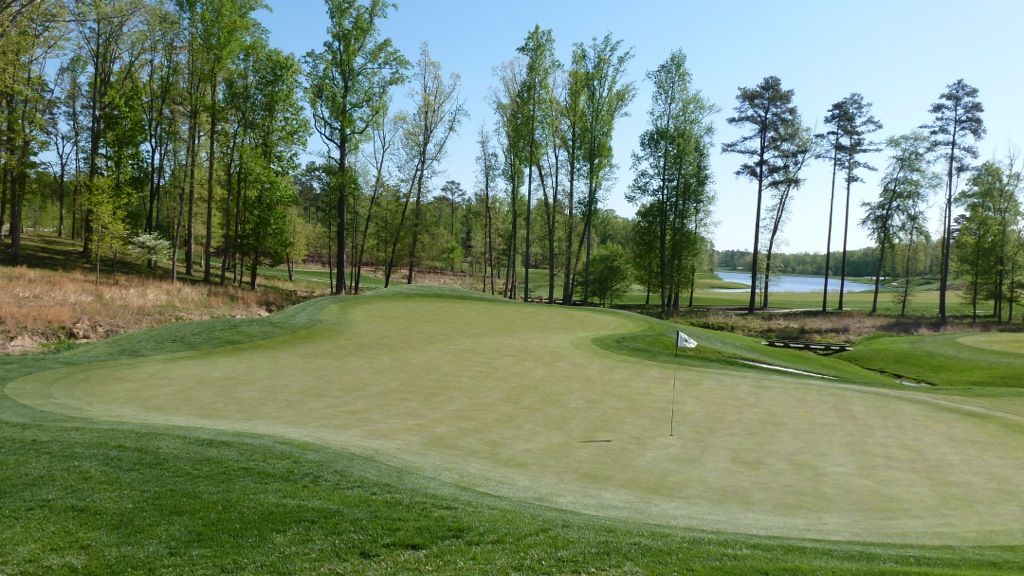

After the reprieve at the 11th, the golfer faces another long and uphill par-4 at the 12th. The green is one of the most severely contoured on the course.

The third par-5 in five holes at the 13th. The golfers eye is drawn to the right, but tee shots should be played away from the Line of Instinct. The second half of the hole plays downhill and the approach to this open-front green begs for a running shot.

The 14th at Kinloch is a 130 yard par-3 set hard against the lake. My first thought was that this short hole was a connector hole to get from the interesting, rolling land that occupies the 13th and 15th holes. From the tee, especially with the pin I played, the hole is easy, simple, boring even.
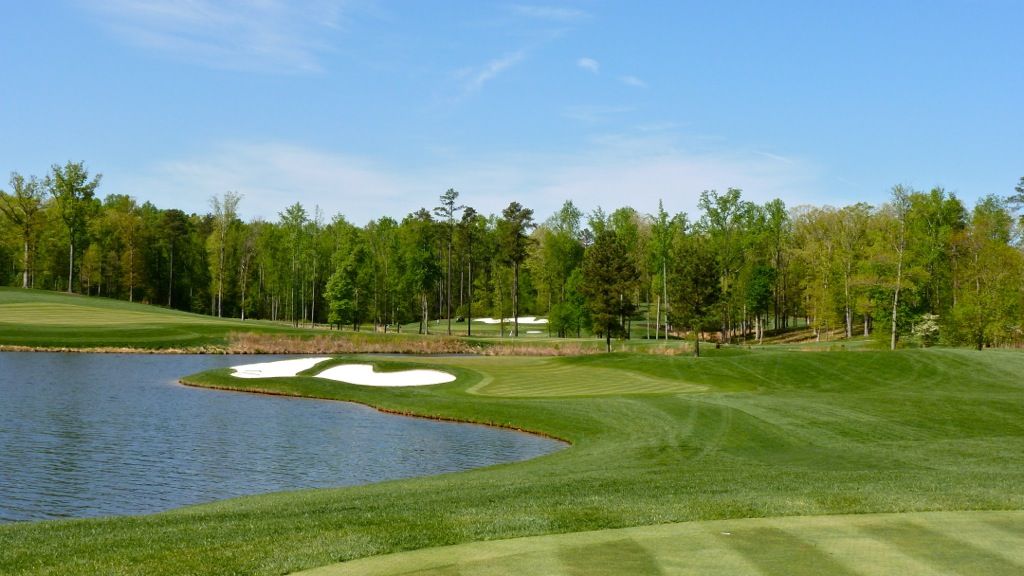
What's amazing is that the entire interest in the hole cannot be seen from the tee. The spine in the centre of the green. The blind portion of the putting surface behind the hill on the right. The angled back edge of the green. Long runs off into the water. What looks easy... is not!

Another split fairway hole at the 15th. Long grass that ran the length of the left side of the hole has been removed and the option to play left for the short route to the green all the more tempting.

But as seen from the left, it is useful to sneak a peak at the pin position when on 12 to help with decision making on the 15th tee.

The 16th is a brutish par-4. The golfer will always be tempted to challenge the carry on the left, but wind direction and choice of tees will determine whether that is a realistic option.

Though this photo was taken from 150 yards out, many approaches will be played from 200 yards or more. The long green is open in front and a small feeder slope will accept running approaches.

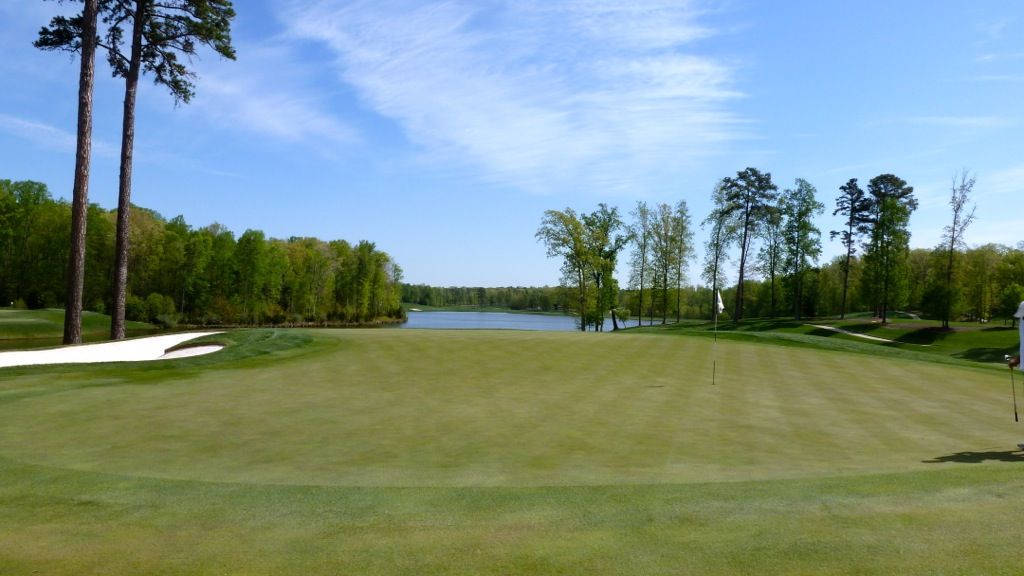
Another visually attractive hole at the subtly difficult 190 yard par-3 17th. It has hard to find a good location to miss this tee shot as a deep swale left and a bunker that plays down the tilt of the green from the right both leave very difficult recoveries.


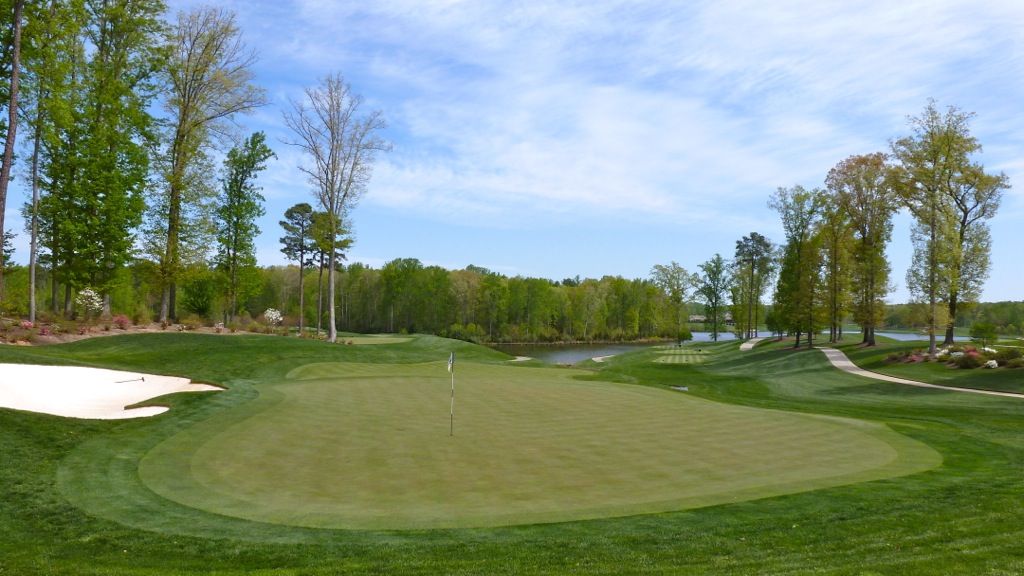
On a golf course known for its decision-making from the tee, the 18th stands in contrast as a hole that demands perfection. Water left; bunkers right -- hit it well or else!
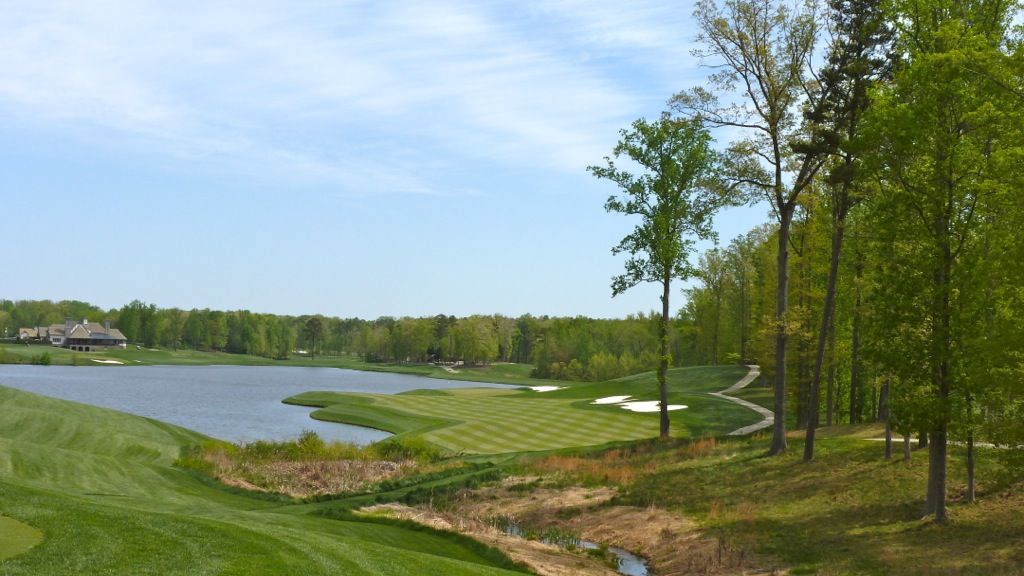


The 19th / bye hole:

Manakin-Sabot, Virginia, United States
Architect: Lester George (2001)
7,203 Yards, Par-72
Rating/Slope: 74.8/139
My Quick Review: Strategic Design; Options; Perfect Maintenance Meld -- Kinloch is a special place!
My only experience with Lester George's work was the excellent renovation of Country Club of Florida, and I could not wait to see what he had created at Kinloch.
Strategic design is alive at Kinloch. Man-made features sit naturally on the land to create decisions that force the golfer to consider the overt man-made hazards and then to question his decision once his ball has reacted with the land. The type of golf course that one must play many times to understand. I can imagine spending a few days on property playing the course over and over would bring the golf course and its strategies to life. I know there are several shots I hope I have the opportunity to play again.
The level of green contour was, to me, surprising. When one considers many of today's top modern designs, they have several, if not many, greens that are extreme. I think Lester designed Kinloch's greens to be played FAST. Their tilts are subtle and for the most part there is little internal contour. Of course, there are exceptions -- the plateau on the 4th green, the spine on the 6th green, the rolls on the 12th green -- but the greens would (I think) be fairly uninteresting if they aren't firm/fast.
I have read that the main criticism of Kinloch is that there are simply TOO MANY split fairway type holes. I think we all know that the split-fairway hole is a very difficult one to execute well as all too often there is only a single realistic option and a second fairway that is maintained without reason. Of course, one would have to play these holes more than just once to really understand them, but I think the split fairway holes at Kinloch are ALL very well done. Equally important, pin position dictates the importance of picking a line.
On to the photo tour...

Handsome cabins complete with lit putting green:

The approach to the up and over first:

An excellent 'bottle hole' at the second, where a trio of bunkers splits the fairway. Playing to the left leaves an at-grade approach up the throat of the the green:

The mid-length par-5 3rd as seen from behind:

The 4th is clearly driveable for some and the decision to play left or right will be dictated by pin position. On this day a hybrid to the right left a simple sand wedge approach into the tilt of the green:

The uphill par-3 5th:

The par-4 6th is a forced lay-up for most, but the golfer must choose whether to lay-up right for the preferred angle or whether to challenge the narrower left portion of the fairway to leave a shorter approach:

The par-3 7th can stretch to north of 230 yards, but plays to a more manageable 190 yards from the 6,500 yard set of tees:

The 8th is a long par-4 where the grade of the fairway creates a speed-slot for golfers taking the bold line from the tee:

An all-carry approach is required at the 8th as a steep false-front is unforgiving:

Options, options, options at the par-5 9th! Golfers hoping to reach the green in two will want to challenge the narrow right fairway; those planning on playing the hole as a three-shotter are fine playing left:

The 9th from behind:

After a long transition, the golfer reaches the long par-4 10th, which is made longer by a fairway that tilts back toward the golfer.


Another split-fairway at the short par-5 5th, that plays downhill and is reachable in two for nearly everyone. The golfer has the option of playing the wider left side, or the narrow right, which widens over a series of bunkers.



After the reprieve at the 11th, the golfer faces another long and uphill par-4 at the 12th. The green is one of the most severely contoured on the course.

The third par-5 in five holes at the 13th. The golfers eye is drawn to the right, but tee shots should be played away from the Line of Instinct. The second half of the hole plays downhill and the approach to this open-front green begs for a running shot.

The 14th at Kinloch is a 130 yard par-3 set hard against the lake. My first thought was that this short hole was a connector hole to get from the interesting, rolling land that occupies the 13th and 15th holes. From the tee, especially with the pin I played, the hole is easy, simple, boring even.

What's amazing is that the entire interest in the hole cannot be seen from the tee. The spine in the centre of the green. The blind portion of the putting surface behind the hill on the right. The angled back edge of the green. Long runs off into the water. What looks easy... is not!

Another split fairway hole at the 15th. Long grass that ran the length of the left side of the hole has been removed and the option to play left for the short route to the green all the more tempting.

But as seen from the left, it is useful to sneak a peak at the pin position when on 12 to help with decision making on the 15th tee.

The 16th is a brutish par-4. The golfer will always be tempted to challenge the carry on the left, but wind direction and choice of tees will determine whether that is a realistic option.

Though this photo was taken from 150 yards out, many approaches will be played from 200 yards or more. The long green is open in front and a small feeder slope will accept running approaches.


Another visually attractive hole at the subtly difficult 190 yard par-3 17th. It has hard to find a good location to miss this tee shot as a deep swale left and a bunker that plays down the tilt of the green from the right both leave very difficult recoveries.



On a golf course known for its decision-making from the tee, the 18th stands in contrast as a hole that demands perfection. Water left; bunkers right -- hit it well or else!



The 19th / bye hole:

Subscribe to:
Comments (Atom)






